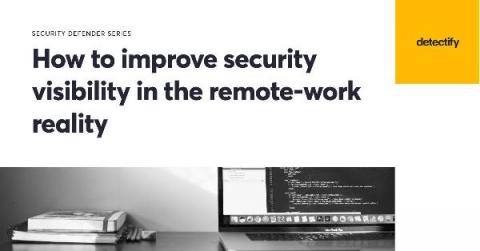Security | Threat Detection | Cyberattacks | DevSecOps | Compliance
Latest News
Employee Productivity Solution For Remote Workers
Remote work gives employees the opportunity to avoid lengthy commutes and work more flexible schedules. It also allows employers to reduce overhead costs and hire from a larger pool of applicants since employees no longer need to live locally to qualify. But of course, there are some downsides to remote work as well. There are far more distractions at home, so many remote workers find it difficult to stay focused during work hours.
Security Defender Insights: Improving security visibility in the remote-work reality
This edition of Detectify Security Defenders Insights focuses on best practices on how not to lose security visibility in 2021: For many small to mid-sized tech organizations, security visibility is an increasing challenge. 2020 was the true catalyst to their tech transformation from all in-house to suddenly working from home. This meant a pressured effort to make sure security was top-of-mind especially now that everyone was literally out-of-sight.
Top 5 Construction Technology Trends to Watch in 2021
The construction industry is not unfamiliar with disruption. In 2008, the Construction Engineering Index plunged 68 percent. Firms that survived the financial crisis that year faced severe margin pressure – dropping from 5 percent in 2007 to 1 percent by 2010. The industry had to act fast and looked for more innovative ways to cut costs and boost profitability. The industry had to act fast and looked for more innovative ways to cut costs and boost profitability.
Hacking Pandemic Workplace Isolation to Enhance Collaboration
Since the onset of the pandemic, many workplaces were suddenly merged into home spaces. In my case, my bedroom became my office. In this new mode of working, what I missed the most is the office chatter and the water cooler conversations which often lead to some brilliant ideas for a new project or design solutions to a technical problem.
Could Universities' Use of Surveillance Software Be Putting Students at Risk?
Life for university students has changed massively during the coronavirus pandemic, as it has for all of us. While some in-person lectures and seminars are still taking place, there has been a big shift to remote learning. This has, perhaps understandably, led to concerns about how well students are engaging with this way of studying. Many universities have sought to address this by turning to remote monitoring tools to track students’ online activities.
Securing a distributed workspace: A cybersecurity checklist for long-term remote work
One of the lasting changes brought about by the COVID-19 pandemic is that it forced organizations to rethink the concept of a workspace. As remote work became inevitable, IT teams had to enable the secure transition to remote work almost overnight. Opening up offices, on the contrary, will likely be executed in planned phases. A United States Department of State advisory recommends that workforces return to an office in three phases, with the employees most at risk coming in at a later stage.
Insider Threats: Risk Assessment Considerations for Remote Work
The outbreak of COVID-19 has led many businesses to transition a large number of employees to remote work. The shift could end up becoming a long-term trend; it’s expected to continue after the pandemic ends. Therefore, it is more important than ever to develop strategies for managing and responding to risks within your organization. Internal risk management procedures will need to adapt to the issue of insider threats, a challenge which is compounded by remote work.
Remote Work and Data Security: The Human Factor
If you read our earlier blog, you know Egnyte commissioned a study to better understand how COVID-19 has impacted businesses’ ability to maintain data security and governance with a distributed workforce. The results can be found in our inaugural Data Governance Trends Report. The report offers insights into tools that the 400 IT leaders implemented to help weather the abrupt change, but it also explains the human side of data protection and governance in the age of COVID.
Top 5 WFH Security Risks - and How to Avoid Them
IT leaders are being kept up at night by one big worry: the increased risk of a data breach due to more employees working remotely. Forty percent say this is their top concern when it comes to remote work. And with good reason. Remote work, especially when accelerated by events like COVID-19 pandemic, compels employees to work on unsanctioned devices, apps, and networks, increasing the attack surface for bad actors, and leaving few checks in place for careless behavior that leads to data leaks.










